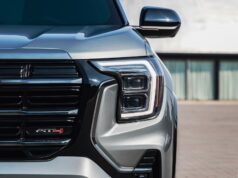The days of models like the 3000GT, Eclipse and even the Lancer Evo are long gone! Sad face! Now Mitsubishi is ditching its past and trying to regain market share by focusing all of its energy on SUVs. Even the really old Lancer is about to go away this summer. So what does that mean for the fledgling automaker?

Related: Mitsubishi GT-PHEV concept previews Mitsubishi’s future
For now Mitsubishi’s lineup will mainly focus on the Outlander and Outlander Sport models, plus the cheap Mirage. While Mitsubishi has yet to release an all-new version of either Outlander models, both of them received a facelift for the 2016 model year. Is it a good band aid to help stop the bleeding at Mitsubishi? Let’s see…
The Outlander Sport has been on the market since the 2011 model year, so it’s definitely showing its age. To give the Outlander Sport an update, Mitsubishi added a new “Dynamic Shield” face, 18-inch alloy wheels, a redesigned steering wheel, new 6.1″ Display Audio, new seat fabrics and power folding side mirrors. Are the changes enough to make the Outlander Sport a true competitor in the ever-growing compact SUV segment? Not really.
When the Outlander Sport debuted it was part of a segment that was in its infancy stage, but now there are so many competitors that the Outlander Sport is now lost in the mix. On the outside few people will notice the new face and especially since everything from the A-pillar back stayed the same, most people will barely notice that it’s been updated.
Inside the interior updates needed to go a bit further. The upgraded materials and new technology do help, but it needs more. Most of the interior is still covered in cheap, hard plastic and the new audio system feels like it’s already a few years old. Where’s Apple CarPlay or Android Auto? Luckily there are some good things to highlight about the interior, it is comfortable and spacious for the overall size of the Outlander Sport. The seats are supportive and comfortable, plus with the optional panoramic roof makes the interior feel even more spacious and welcoming.
Under the hood, the Outlander Sport can be powered by either a 148-hp 2.0L or 168-hp 2.4L four-cylinder. A five-speed manual is standard, but a CVT is optional as well as front- or all-wheel drive. The fuel economy specs aren’t that great for the Outlander Sport with the 2.0L getting up to is rated at 24/30 with front-wheel drive and CVT, and the 2.4L with all-wheel drive and the CVT rated at 22/27 mpg. Mitsubishi gave me the keys to the Outlander Sport GT, which is powered by the 168-hp engine that sends the power to the ground via the CVT and all-wheel drive system. How does it drive?
Around town the Outlander Sport GT has adequate acceleration and its small footprint makes it perfect for urban dwellers. If you’re hoping that the “sport” in its name means that it actually has some sportiness to it, you’ll be disappointed. The electric power steering is incredibly light and the suspension is tuned a bit too soft for an enthusiast. But if you’re at the other end of the spectrum, as most small SUV buyers are, the Outlander Sport GT’s ride is comfortable and easy to maneuver. Push the pedal to the floor and you’re greeted with too much buzzing from the engine and CVT and not much speed. On highlight for the all-wheel drive model is that unlike most crossovers, you can manually select front-wheel drive, auto all-wheel drive or lock the all-wheel drive system on permanently.
Pricing starts at just over $20k for the 2016 Outlander Sport, but can go up to as high as just over $28k for the fully-equipped 2.4L GT. At the end of the day, if you’re looking for a small, slightly inexpensive SUV with a long warranty check out the Outlander Sport, if you want something with the latest tech and a bit more sport, check out the Mazda CX-3, Honda HR-V and even the upcoming Toyota C-HR.













